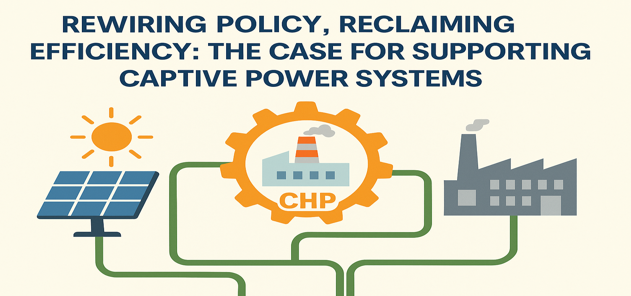Annual Meeting of Pakistan Textile Council – 30th August 2025 – Karachi
REWIRING POLICY, RECLAIMING EFFICIENCY: THE CASE FOR SUPPORTING CAPTIVE POWER SYSTEMS
admin
May 1, 2025
Blog

Writer: MR. ASIM RIAZ AN ESTABLISHED ENERGY EXPERT, M.PHIL. STRATEGIC STUDIES NDU,MASTERS IN ENERGY MANAGEMENT CIIT, B.SC. (MECHANICAL) UET, BS. MATH-PHYSICS PU.
Captive power systems—particularly those deploying Combined Heat and Power (CHP) technologies—offer compelling climate advantages due to their superior thermal efficiency and ability to utilize waste heat, thereby reducing fuel consumption and lowering overall carbon emissions. These systems are far more efficient than conventional grid-based power generation, especially under partial load conditions.
Their decentralized nature also helps reduce transmission losses, enhancing the overall efficiency of the energy system. When integrated with behind-the-meter solar PV, captive setups evolve into hybrid energy solutions that not only reduce reliance on fossil-based grid electricity but also minimize Scope 2 emissions. This is particularly important for industrial exporters, who must comply with emerging Carbon Border Adjustment Mechanism (CBAM) regulations, which penalize carbon-intensive products.
By enabling cleaner production, these systems strengthen Pakistan’s position in carbon-sensitive export markets and contribute meaningfully to national climate targets. Beyond emissions reduction, captive systems serve as flexible enablers of renewable energy integration. Their ability to ramp quickly makes them ideal for stabilizing the grid amid fluctuating output from variable renewable energy (VRE) sources like solar and wind. In doing so, they support grid resilience, provide critical ancillary services, and contribute to a more sustainable, job-intensive energy future—generating up to three times more employment than centralized generation.
Penalizing such systems through poorly designed levies undermines both environmental progress and industrial competitiveness. Instead, targeted incentives and regulatory support should be extended to accelerate their deployment. To address the structural inefficiencies, fiscal pressures, and policy misalignments detailed above, the following reforms must be implemented as a matter of priority.
These interventions are essential to restoring industrial gas demand, enabling competitive market access, and strengthening institutional governance across the energy value chain. In parallel, they will support Pakistan’s compliance with evolving international climate regulations—most notably the Carbon Border Adjustment Mechanism (CBAM)—by enhancing the decarbonization profile of the industrial export sector and reinforcing alignment with global trade and sustainability benchmarks.
These interventions are essential to restoring industrial gas demand, enabling competitive market access, and strengthening institutional governance across the energy value chain. In parallel, they will support Pakistan’s compliance with evolving international climate regulations—most notably the Carbon Border Adjustment Mechanism (CBAM)—by enhancing the decarbonization profile of the industrial export sector and reinforcing alignment with global trade and sustainability benchmarks.
Recommendations
- Suspend the Captive Gas Levy Ordinance immediately to prevent further erosion of industrial gas demand, mitigate RLNG oversupply risks, and contain the growth of gas sector circular debt.
- Implement cost-reflective, marginal pricing for captive gas consumers based on RLNG benchmarks, in line with Section 7(2) of the OGRA Ordinance, ensuring economic rationality and legal compliance.
- Establish an integrated energy planning framework that aligns gas and power sector policies, optimizing infrastructure utilization, resource allocation, and long-term supply security.
- Accelerate gas market liberalization, including the functional and legal unbundling of SNGPL and SSGC, full enforcement of Third Party Access (TPA), and enabling competitive gas sales by private shippers.
- Incentivize high-efficiency captive systems, particularly Combined Heat and Power (CHP) and hybrid renewable-captive configurations, through predictable pricing, regulatory certainty, and grid support recognition.
- Restructure institutional governance by creating distinct, empowered divisions for gas and power within the Ministry of Energy, enhancing coordination, reducing policy fragmentation, and enabling evidence-based decision-making.
Recent Posts
News
Blog
Have Any Question?
- +92 51 2726971
- info@ptc.org.pk
